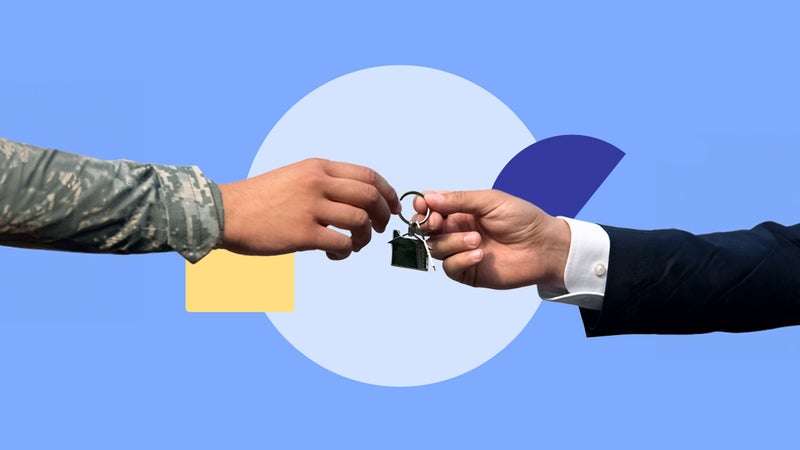How to get a VA home loan

The Bankrate promise
At Bankrate we strive to help you make smarter financial decisions. While we adhere to strict , this post may contain references to products from our partners. Here's an explanation for .
Key takeaways
- VA loans are available to active-duty military personnel, veterans and surviving spouses who need to finance a home purchase.
- You must provide a VA-approved lender with a certificate of eligibility (CEO) to prove you qualify for a VA loan before you can get preapproved.
- The VA loan process also involves getting your new home appraised, going through mortgage underwriting and closing on the loan.
Eligible veterans, active-duty personnel and surviving spouses looking for a home can use a VA loan for financing. These types of mortgages, which are guaranteed by the U.S. Department of Veterans Affairs and available through lenders nationwide, tend to offer attractive fixed-rate loans with no (or little) money down. VA loans are also known for their more flexible credit score requirements. Here’s what you need to know about the VA loan process.
How to get a VA loan: Step-by-step
Here’s what a typical VA loan process looks like:
Step 1: Determine if you are eligible for a VA loan
Before you start shopping for a VA loan, figure out if you meet the VA loan eligibility requirements, which include:
- Length of service: For active-duty service members, you are eligible if you have served for at least 90 days continuously (without a break in service). For veterans, National Guard members and Reserve members, the requirements depend on when you served. You can find this information on the VA website.
- Credit score: While there’s no minimum credit score required for getting a VA loan, approval comes down to each lender, and many lenders will want to see a credit score of 620 or higher.
- Debt-to-income (DTI) ratio: You must demonstrate that you have sufficient income and an acceptable DTI ratio, usually no more than 41 percent, although some lenders might go slightly higher.
You will also need to get a certificate of eligibility, or COE, since it shows that you meet the initial eligibility criteria for the loan. To get a COE, check the eBenefits portal on the VA.gov website or contact the VA for help. Borrowers may also be able to apply through their lender.
- Driver’s license or other government-issued ID
- Recent financial information, including W-2s, pay stubs and bank statements
- For active-duty members, a signed statement of service
- For veterans, discharge or separation papers (also known as form DD214)
- For surviving spouses, a marriage certificate or license
In addition, there are restrictions on how to use a VA home loan. You must intend to use the home as a primary residence and occupy it within 60 days after closing.
Step 2: Shop around for a VA-approved lender
Once you’ve determined your eligibility, you will need to find a mortgage lender that participates in the VA loan program. If you need help finding a VA-approved lender, you can contact a local Veterans Service Organization (VSO) representative who can provide a list of lenders in your area.
After getting connected with a loan officer, they can help you identify the documents needed and what size loan you can qualify for. Be sure to shop around, since different lenders can offer deals that vary by interest rate, closing costs and discount points.
Step 3. Get preapproved for a VA loan
If you want to know how to apply for a VA home loan, the first step is to get preapproved. Getting preapproved for a mortgage shows sellers you’re serious about purchasing a home and that lenders deem you creditworthy to borrow money from them. It’s a statement or letter indicating how much, in principle, they will lend you. It’s not a guarantee of the mortgage — for that, you need to present a specific property for appraisal and possibly additional documentation — but it’s an important first step.
To start the preapproval process, reach out to a VA-approved lender. You’ll submit an application and provide financial documentation, such as bank statements and past tax returns. The lender will also run a hard credit check to see your credit score and determine your creditworthiness. With all that information, the lender will determine how much money you are eligible to borrow, and at what interest rate.
Step 4. Find your home
Once you know how much money you are preapproved to borrow, you can start shopping for homes. Work with a real estate agent who understands VA loans; better still if this person specializes in helping members of the military. Veteran-friendly agents can help you understand what to look for in terms of maximizing your benefits.
Your agent’s job is to help you craft a strong offer and formulate a sound negotiation strategy. Once you’ve got an accepted offer and hammered out the details, you’ll sign a purchase and sale agreement with the seller.
Don’t forget contingencies: These can include how long you have to secure financing, the amount of earnest money you’ll need and the right to have a home inspection. It can also include sellers paying for some or all of the VA closing costs.
Step 5. Go through a VA home appraisal and inspection
A VA-approved appraiser will determine the home’s value. This person will also help you assess whether a property meets the VA’s property condition requirements, or Minimum Property Requirements, and VA home appraisal guidelines.
This is also the stage where you’ll commission a home inspection if that was agreed upon in the purchase and sale agreement. VA loans do not require a home inspection, but it’s generally recommended that you shouldn’t skip this step. You’ll be able to get to know your property better and back out of the deal if you can’t get the seller to agree to make certain repairs before closing.
During the inspection, the home inspector will ensure that the home meets the Minimum Property Requirements. Some of the things on this list include:
- Space requirements
- Property access and encroachments
- Hazards
- Utilities
- Swimming pools
- Home structure
- Signs of deterioration
- Proximity to airports
Step 6. Complete the mortgage underwriting process
Your bank or lender’s underwriters will need additional documentation to evaluate your loan eligibility and make sure that you’re “cleared to close.” Documents you might need to submit include:
- Proof of income
- Bank statements
- Tax returns
- Identity verification
- Government-issued photo ID
- Certificate of eligibility
Step 7. Close on your new home
The closing step is where you’ll sign documents indicating that you understand and agree to your loan terms. Before your scheduled loan closing, you’ll receive a document called a closing disclosure, where you’ll be able to see a breakdown of your final VA closing costs.
The typical costs include a funding fee, which varies from 1.5 percent to 3.3 percent of the loan amount. Usually, the higher your down payment on a VA loan, the lower the fee. There are also exceptions: Surviving spouses and veterans with service-connected disabilities don’t have to pay the funding fee.
A day or so before signing, you can also do a final walkthrough of the property. Once you sign all the closing documents, including the purchase agreement, you’ll receive the keys to your new house.
After closing, the VA will return your certificate of eligibility with a note stating that you have used (all or part) of your VA mortgage loan entitlement. Qualified borrowers can use their eligibility more than once to obtain a loan on a new home they intend to live in.
VA loan process vs. other loan types
The VA loan process can take longer than that of conventional loans since there are more documentation requirements as part of the appraisal and inspection process. However, borrowers who qualify for a VA loan could get more favorable terms than they would with a conventional mortgage or FHA loan.
VA loan process FAQ
-
A certificate of eligibility (COE) serves as evidence that you meet the VA’s mortgage eligibility requirements. To get a COE, you can apply through the VA eBenefits online portal, ask your mortgage lender to help or apply via mail.
-
The VA does not require a home inspection and doesn’t impose requirements on home inspections. Regardless, a home inspection is an important step toward ensuring that your desired property is safe and fit to live in — don’t skip this step.
-
Some pros of VA loans include their no money down and no mortgage insurance requirements, so you can buy a home for little cost upfront and avoid mortgage insurance payments. VA loan interest rates also tend to be lower than other loan options. Eligible borrowers may also find that VA loans are easier to qualify for compared to other kinds of loans.




